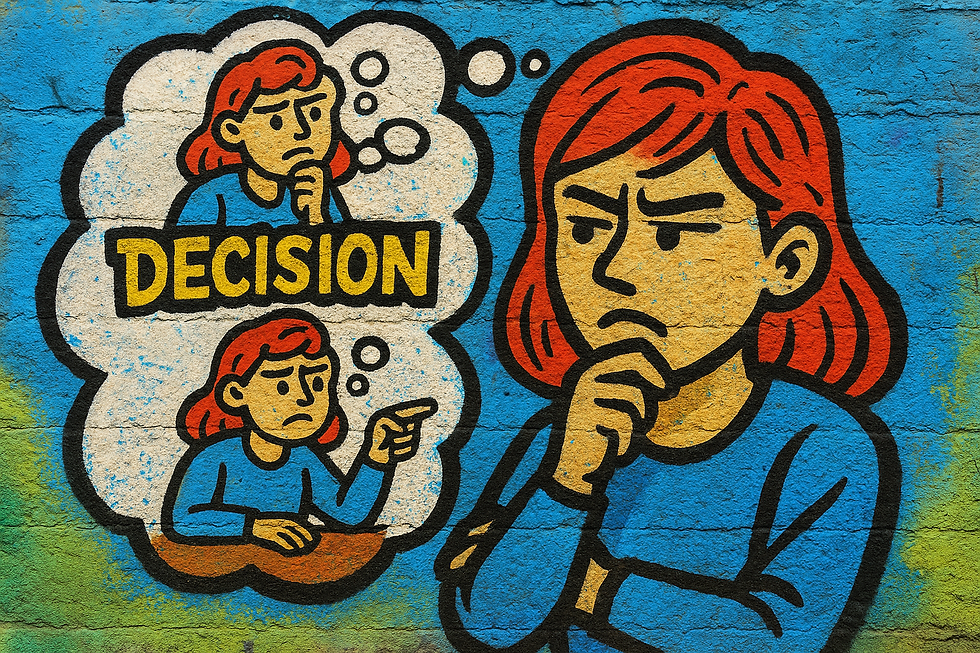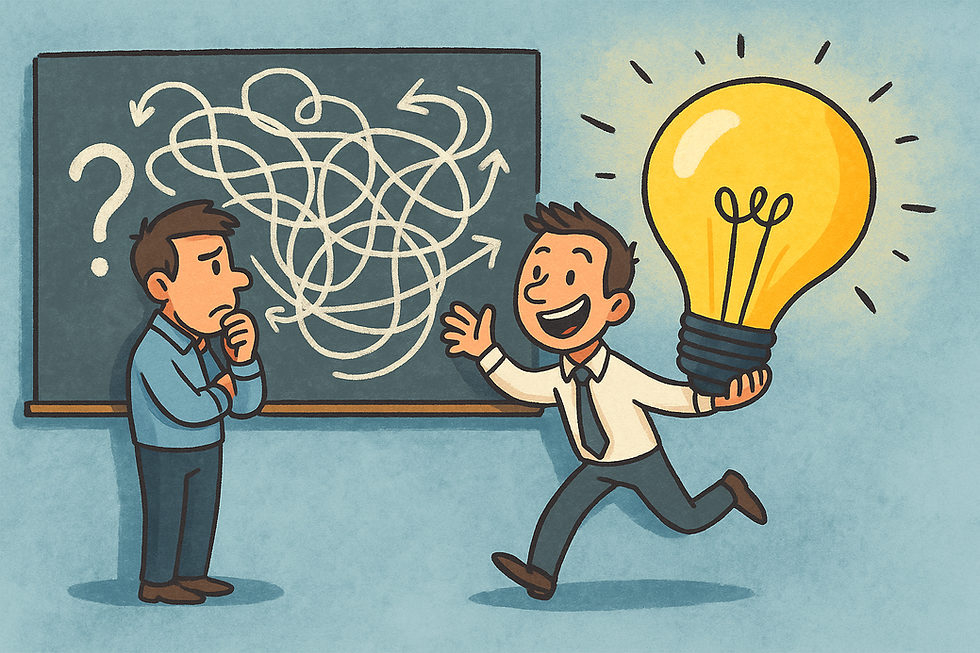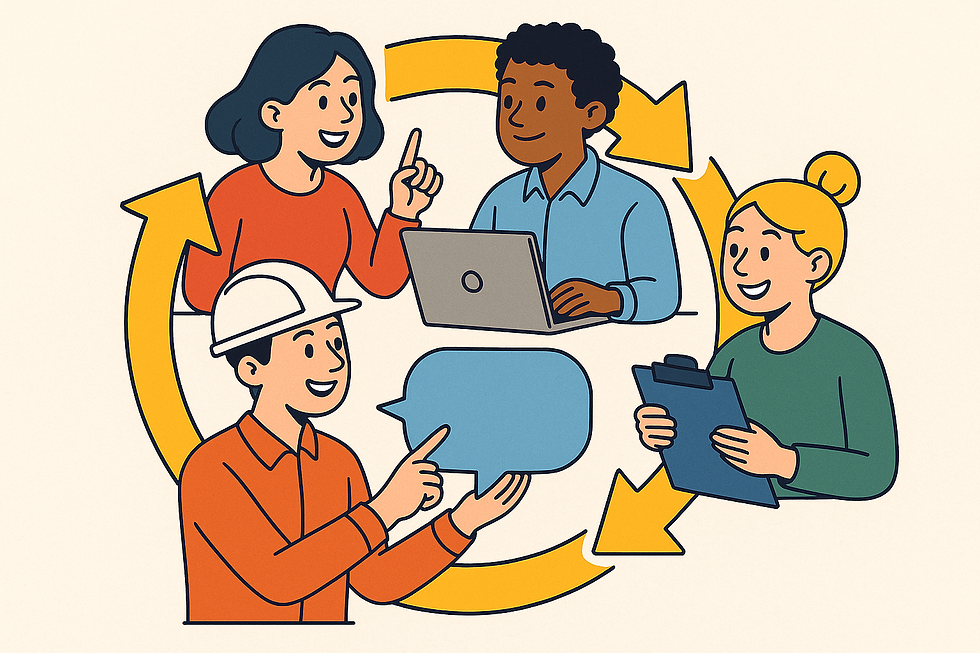Decision Making in Projects: From Activity to Effective Action
- Anne Werkmeister
- Sep 3, 2025
- 7 min read

Why I Chose to Write About Decision-Making
Before we dive into decision-making frameworks, let me pull back the curtain on a decision I just made, the choice to write this article in an unconventional way.
Because here's the thing: the best way to understand decision-making is to watch it in action.
The Trigger: It started with a simple thought: "I should write about decision-making."
But wait..., why that thought? What invisible force made my brain suddenly prioritize this topic over the thousand other things I could write about?
This is the ghost in the machine of decision-making: the decision to decide. Most frameworks skip this entirely, jumping straight to "Here's how to make better choices." But they miss the crucial moment: What makes us recognize that a choice needs to be made in the first place?
My Personal Archaeology: Digging into my own thought process, I realized several forces were quietly converging:
A growing frustration with watching smart people make consistently poor choices
Recent conversations where I noticed people treating decisions like coin flips
An unconscious pattern recognition: "This keeps coming up, there must be something here worth exploring"
A nagging sense that we're all winging it when it comes to choices that actually matter
The Meta-Realization: I wasn't just deciding to write about decision-making, I was experiencing the exact phenomenon I wanted to explore. That moment when your unconscious mind taps your conscious mind on the shoulder and says, "Hey, this situation requires some intentional thinking."
The Deciding Factor: I realized that if I couldn't make an article about decision-making itself demonstrate good decision-making, then what was the point?
The Decision Paradox That's Eating Our Time
But first, let's explore something even more fundamental: When do you decide that you need to make a decision?
Picture this: You're living your life on autopilot, coffee, commute, meetings, email, repeat. Then suddenly, something breaks the pattern. Maybe it's a feeling of unease. Maybe it's a conversation that sticks with you. Maybe it's noticing the same problem cropping up repeatedly. Something in your mental periphery whispers: "This needs attention."
The Wake-Up Call Moments:
When the status quo starts feeling like quicksand
When you catch yourself avoiding something for the third time this week
When a small voice in your head says "There has to be a better way"
When you realize you're solving the same problem over and over
When someone asks you a simple question you can't answer
These are your decision triggers, the early warning system that tells you it's time to shift from autopilot to intentional choice-making.
Picture this: You're a manager who spends 37% of your day making decisions. That's roughly 3 hours out of every 8-hour workday spent in the mental gymnasium of choice-making. Yet here's the kicker, more than half of that time is wasted on ineffective decision-making.
The culprit? We've been treating decisions like lightning strikes, sudden, isolated events that either illuminate the path forward or leave us stunned in the darkness. But what if I told you that great decisions aren't lightning strikes at all? They're more like carefully tended gardens, cultivated through a deliberate process that transforms uncertainty into clarity.
Deconstructing the Decision Myth
Let's shatter a dangerous misconception right now: There is no single "eureka!" moment in quality decision-making. That's Hollywood nonsense. Real decision-making is a symphony, not a solo performance. It's a process with movements, themes, and yes, sometimes discordant notes that need to be resolved.
Think of it this way: When you're facing a significant choice, you're not just picking Option A or Option B. You're essentially becoming a detective, an architect, a diplomat, and a fortune-teller all at once. Sound overwhelming? It doesn't have to be.
The Blueprint: Your 8-Stage Decision Architecture
Stage 1: The Problem Sculptor
"Every block of stone has a statue inside it, and it is the task of the sculptor to discover it." – Michelangelo
Before you can solve a problem, you need to sculpt it from the raw marble of confusion. This isn't about jumping to solutions, it's about becoming intimately acquainted with the true shape of your challenge.
The Question Behind the Question: Don't ask "What should we do?" Ask "What are we really trying to achieve, and what's actually preventing us from getting there?"
The Mirror Test: Can you explain this problem to a complete stranger in under two minutes? If not, you haven't sculpted it yet.
Stage 2: The Ensemble Cast
"Talent wins games, but teamwork and intelligence win championships." – Michael Jordan
You know what kills great decisions? The lone genius myth. The idea that the smartest person in the room should make all the calls. Michael Jordan understood something profound: individual talent can handle the routine plays, but when you're going for the championship, when the stakes are highest and the pressure is on, you need orchestrated intelligence.
" Where all men think alike, no one thinks very much." – Walter Lippmann
But here's Lippmann's warning haunting every conference room: the moment everyone starts nodding in agreement, you've probably stopped thinking altogether. True group intelligence emerges not from harmony, but from the productive friction of diverse perspectives.
Here's the reality: You can't see your own blind spots. That's why they're called blind spots.
The Newcomer's Eye: Include someone who's never handled this problem. Their questions cut through assumptions.
The Experience Vault: Balance fresh eyes with people who've seen this movie before. You need both "Why do we do it this way?" and "Here's why we stopped doing it the old way."
The Goldilocks Principle: Too small a group, and you miss crucial perspectives. Too large, and you get decision-by-committee mediocrity. The sweet spot? 5-7 people for most significant decisions.
The Silent Start: Begin important decision meetings with 5 minutes of silent, individual brainstorming. This prevents the loudest voice from anchoring everyone else's thinking.
Stage 3: The Time Alchemist
"Time is what we want most but what we use worst." – William Penn
Time is your most misunderstood ingredient in decision-making. We always complain about not having enough time to make good decisions, yet when we do have time, we often waste it on endless deliberation about choices that don't warrant it. Too little time, and you get half-baked choices. Too much, and you get analysis paralysis.
The Urgency Matrix: Draw a simple 2x2 grid. On one axis: "Reversible vs. Irreversible." On the other: "High Impact vs. Low Impact." Your time allocation should follow this map religiously.
The 10-10-10 Rule: How will you feel about this decision in 10 minutes, 10 months, and 10 years? This cuts through emotional noise instantly.
Stage 4: The Rules of Engagement
"In the absence of clearly defined goals, we become strangely loyal to performing daily acts of trivia." – Robert Heinlein
Here's where most decision-making processes die: in the murky waters of unclear roles and undefined processes. Everyone assumes someone else is steering the ship.
The RACI Revolution: For every decision, assign clear roles:
Responsible: Who's actually doing the work?
Accountable: Who's ultimately answerable for the outcome?
Consulted: Whose input do you need?
Informed: Who needs to know about the decision?
The Devil's Advocate Clause: Explicitly assign someone to poke holes in every argument. Make skepticism a role, not a personality flaw.
Stage 5: The Intellectual Cage Match
"The opposite of a correct statement is a false statement. But the opposite of a profound truth may well be another profound truth." – Niels Bohr
This is where the magic happens, where good ideas go to battle and great ideas emerge victorious. But most teams are terrible at productive conflict.
The Steel Man Technique: Don't attack weak arguments. Build the strongest version of every option, then see which survives.
The Red Team Exercise: Divide your group. Half argues passionately for Option A, half for Option B. Then switch sides. You'll be amazed at what emerges when smart people are forced to argue against their initial instincts.
Stage 6: The Implementation Insurance Policy
"A goal without a plan is just a wish." – Antoine de Saint-Exupéry
Most decisions fail not because they were wrong, but because no one thought about what it would actually take to make them work. Saint-Exupéry understood this fundamental truth about human nature: we're excellent at imagining outcomes but terrible at mapping the journey. In boardrooms across the world, brilliant decisions die not from lack of vision, but from lack of execution architecture.
The Pre-Mortem: Before implementing your decision, imagine it's failed spectacularly. What went wrong? This isn't pessimism, it's implementation insurance.
The Resource Reality Check: For every decision, ask: "What would have to be true for this to work?" Then verify those conditions actually exist or can be created.
Stage 7: The Alignment Alchemy
"Buy-in isn't something you get – it's something you build."
The final stage isn't about announcing your decision; it's about transforming a choice into a shared commitment.
The Explanation Architecture: Don't just announce what you decided, explain the why, acknowledge the alternatives you considered, and address the concerns that were raised. People can disagree with a decision and still commit to it if they understand the reasoning.
The Implementation Story: Paint a picture of what success looks like. People need to see themselves in the story of your decision's success.
Your Decision-Making Diagnostic: A Quick Health Check
Here's your practical takeaway, a simple diagnostic you can run on any significant decision you're facing:
The Clarity Test: Can you state the problem in one sentence?
The Team Test: Do you have both fresh eyes and experienced hands?
The Time Test: Does your timeline match the decision's importance?
The Process Test: Does everyone know their role?
The Conflict Test: Have you actively sought out opposing views?
The Reality Test: Have you planned for implementation challenges?
The Commitment Test: Will your team actually execute this decision?
The Decision Maker's Creed
"I will not mistake activity for progress, consensus for quality, or speed for effectiveness. I will treat decision-making as a craft to be honed, not a burden to be endured. I will remember that the best decisions aren't perfect; they're simply better than the alternatives and executable by the people who must live with them."
The Bottom Line: Decision-making isn't about being right all the time. It's about building a reliable system that consistently produces better choices than your competition. In a world where everyone has access to the same information, your decision-making process might be your only sustainable competitive advantage.



Comments